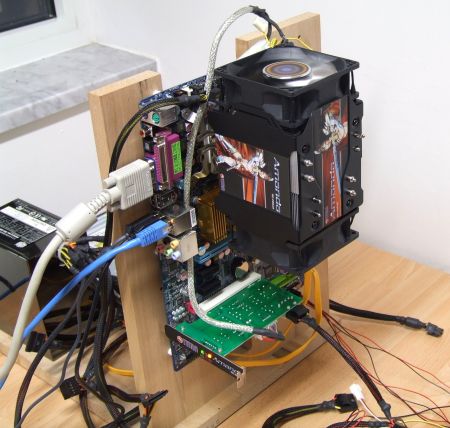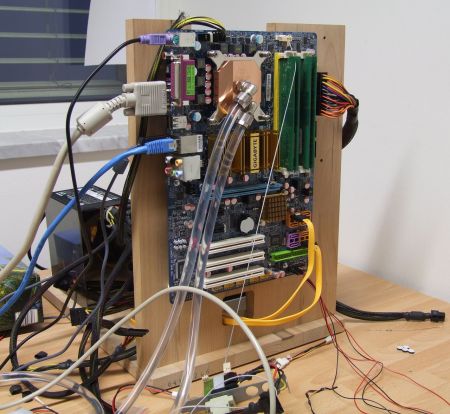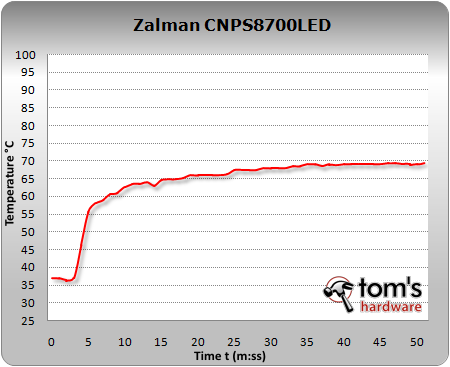CPU Cooler Charts 2008, Part 1
The Test Platform And Methodology - Four Cores Under Load
We tested all of the coolers in this roundup on an Intel quad-core Core 2 Extreme QX6850 CPU. When all four cores are under full load, this model has a power consumption of 113.87 watts. In order to achieve this load, we use a multi-core version of Prime95 (ver.25.5a). The CPU displayed this power consumption when combined with the best water cooler we tested, reaching 62°C. The worse the cooler performs, the more energy the CPU will consume, as it will be operating at a higher core temperature. We decided to conduct the cooler tests on a quad-core processor with a high thermal dissipation, since many users overclock their processors, and coolers need to be able to satisfy these more sophisticated needs.
The cooler test setup.
The test platform with a water cooling solution installed.
The coolers were tested in a Gigabyte GA-G33-DS3R board with integrated graphics core mounted upright, the way it would be installed inside a tower case. Since most coolers these days utilize heatpipe systems to conduct heat away from the CPU, the position and orientation of the cooler can have a tremendous effect on its cooling performance, and by extension, its efficiency. Orientation may also impact the noise level of air-based cooling solutions. The temperatures of all four processor cores are measured directly at the digital temperature sensors (DTS). We calculate an average temperature and then create a line diagram from the data.
The duration of the measurement is determined by the maximum temperature that the cooler reaches. A very bad cooler may reach its highest temperature in a matter of seconds, while at the other extreme, a very efficient water cooler may take up to half an hour.
In this example diagram, the Zalman cooler has reached its final temperature of nearly 70°C after about 55 seconds.
Get Tom's Hardware's best news and in-depth reviews, straight to your inbox.
Current page: The Test Platform And Methodology - Four Cores Under Load
Prev Page The Heat Is On - CPU Coolers Compared Next Page The Criteria - Cooling, Noise And Ease Of Installation-
Thank you, been wondering what cooler to buy for an OCed Quad, and high temps are good when dying :DReply
-
suspect I cant believe that photo...sorrii I am with you only a nutjob would use or test it in that configuration!!!Reply
Noctua clearly state orientation of their coolers and that is ass about.
Every other review I have read rates the NH-U12F much more highly... always near best in class -
wkornf your numbers of near 70C on every cooler is outrageous, if those numbers are true not a single one of these coolers would keep a computer stable in a closed case outside the northeast. and a couple minutes isnt a good measure of cpus final temp, if u look over a temp log after a long game session you know it creeps up. to many factors.Reply -
dragunover Bullshit article.I agree with wkornf.Reply
If my Artic silver 5 + Scythe Katana 2 cooler(for only a massive price of 25 USD! I can keep my outdated Pentium D under 100 degrees fahrenheit,infact around HALF of these tests,even under water cooling? Wow,according to this,I should actually worry about getting a quad core because of the heat.And no,I don't have any fans in my case,it's open,only fans are from my GPU,CPU,and my PSU.
No extra 4 250mm performance fans.And an X38? That's just unbelievable. -
eaglestrike7339 Do you guys get the point? They maxed out everything, so the cooler could show off the best that it could do in the most extreme conditions.Reply
A good article, i especially like the tests for installation and sound, as those are what i would look into most when purchasing a cooler, and unlike CPUs, there are usually no charts to go along with. -
suspect eaglestrike... do you see mounting the noctua fan in the wrong direction as good testing???Reply
They have it on the top side of the sink flowing in a downward direction!!!
it goes against basic laws of physics and logic. -
cliffro alot of the coolers listed of a particular design are installed all goofy like, Of course on their open setup it doesn't make much difference(i think)Reply
but when installed in a normal ATX case, would be detrimental to the coolers performance. Especially coolers designed similar to the Noctua and Scythe Ninja plus.
I can't be certain about others but Arctic Cooling's Freezer 7 Pro is supposed to be installed like this(one would assume others of similar design would be the same)
http://bigrockies.com/media/cooler.jpg
-
suspect cliffro I think to some degree you are correct but it still does not follow good practice when supposedly collecting data to represent consumer products.Reply
As these have published manufacturer recomended installations why would you reverse it.
I recently read a review of the latest Noctua cooler at Legitreviews
where Noctua actually contacted them on this very issue... as a result they retested and found some improvement in cooling.
http://www.legitreviews.com/article/741/1/


